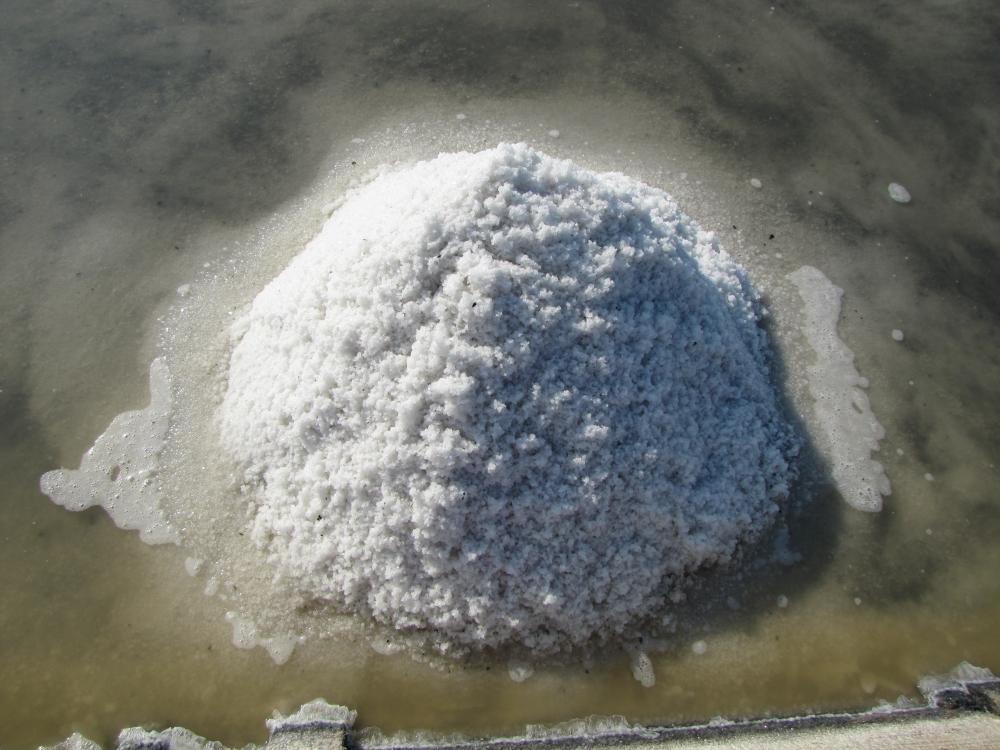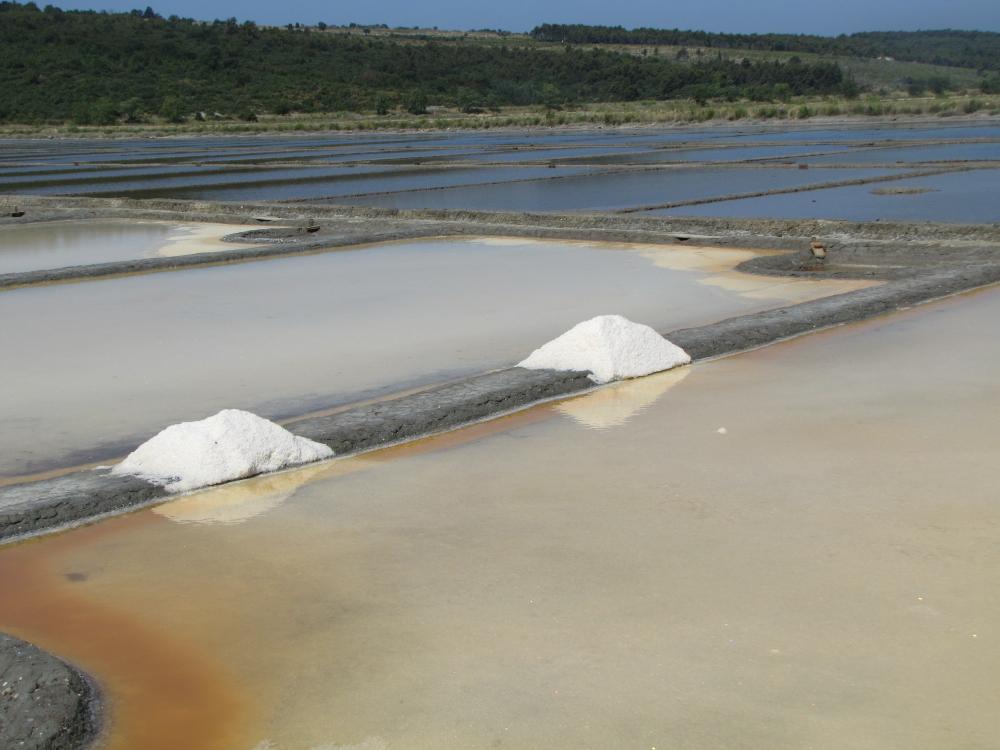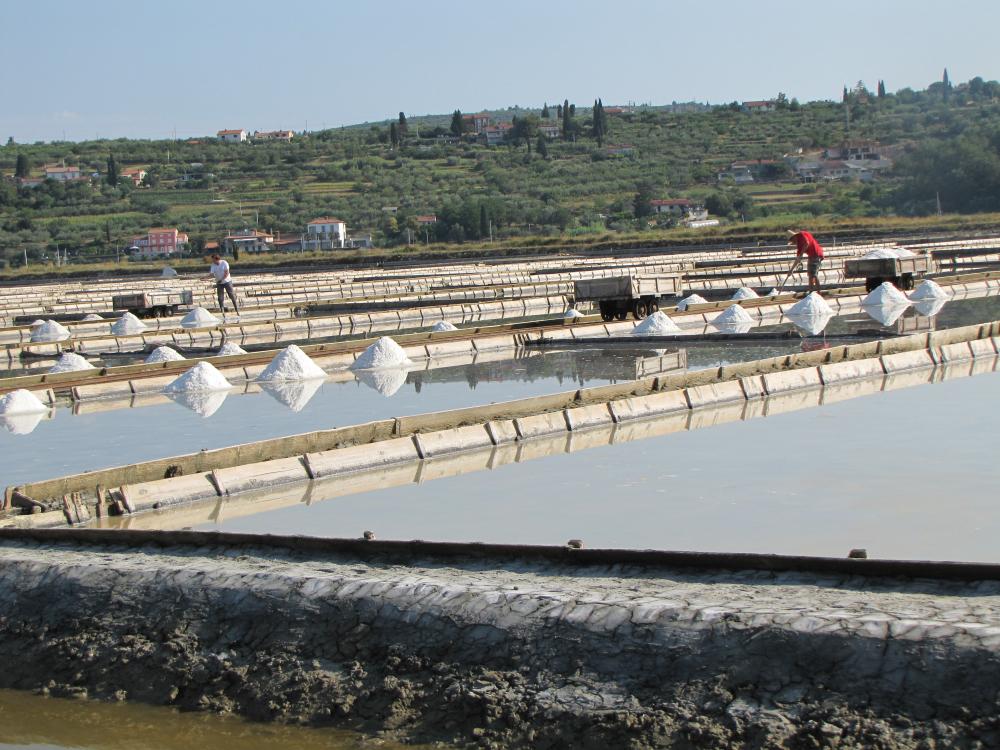
The earliest information on the construction of salt-pans in north-western Istria was recorded in a notarial instrument dating to 1278, by which the Piran consuls permitted a certain Father Baldo from Manfredonia to construct two salt basins in the swampy area of St. Bartholomew’s Channel.

The local people lived well from the salt-pans. They had a sure and steady source of income. If you had a good season at the salt-pans, it wasn’t too bad, if you had a poor harvest in the field.

The main objective is to preserve the original image and content of the salt-pans as much as possible.
This time, we spoke about the salt-pans, which is not only a wetland area, but a beautiful harmony of people’s work and natural processes; only a few animal and plant species can live here. The salt-pans have had a significant influence on the littoral landscape. The systems of channels, levees, salt fields and everything that people created in this area make a wonderful example of equilibrium with the environment. The staff at the Maritime Museum is aware of this exceptional heritage and is studying it closely. One of the people who enriches us with his knowledge is Flavio Bonin. His bibliography is rich andin addition to studying salt production.
What essentially defines salt production in the northern part of the Adriatic, or since its beginnings?
When and how the salt-pans on the northern shores of the Adriatic were created is not really known. The first written sources date back to the 13th century, although it is assumed that salt-pans were present in this region already at the time of the Roman Empire. They are already mentioned in the surviving sections of the town statutes from 1274 and include several regulative decrees as well as rights of people to acquire and trade salt.
To facilitate the flow of seawater, salt-pans were most frequently situated in depressions. In the area of the Slovenian Istria, the best conditions were in the wider area of Piran and on the outskirts of Izola and Koper. The ones in Piran were the largest, encompassing Sečovlje, Lucija and Strunjan salt-pans. The smaller salt-pans in Izola were abandoned in the 18th century and the larger ones in Koper at the beginning of the 20th century.
The earliest information on the construction of salt-pans in north-western Istria was recorded in a notarial instrument dating to 1278, by which the Piran consuls permitted a certain Father Baldo from Manfredonia to construct two salt basins in the swampy area of St. Bartholomew’s Channel. After 1283, when Piran came under Venetian administration, about 1,200 crystallisation basins were said to be in the Piran area. The owners were mostly people of Piran, and almost all were patricians of the town: most were notaries, and also representatives of the church, carpenters, shoemakers, traders and, of course, salt makers.
Which salt-pans have been preserved?
From all units in the Gulf of Trieste, only those in Strunjan and Sečovlje have been preserved. They were part of the Piran salt-pans, together with the ones that are now destroyed in the Fazan Canal in Lucija. The Sečovlje ones are the largest operating salt works, and extend over an area of approximately 650 hectares at the mouth of the Dragonja River near Sečovlje.
In 1989, the Municipality of Piran proclaimed the area of the salt-pans and the Seča peninsula a nature park.
The nature park is divided by the Drnica River (Canal Grande) into the northern and southern sections. In the northern section, called Lera, salt is produced by traditional methods. The southern section, Fontanigge, borders Croatia. Access to the southern section is by a road that starts between the Slovenian and Croatian border crossing. The Sečovlje salt-pans are wetlands of international importance and as such they were included in the Ramsar List of Wetlands of International Significance in 1993 due to their exceptional landscape and ecological values.
Besides the Sečovlje salt-pans, the ones at Strunjan were the most important salt works in the Venetian Republic between the 15th and 17th centuries. They are located on the Gulf of Trieste near the town of Strunjan and are the most northerly salt-pans still operating in the Mediterranean. Work there came to a halt for a while, but salt production using medieval methods is being revived for tourist purposes.
What is the difference between the Strunjan and Sečovlje salt-pans?
There is no major difference really; the technology of salt production is the same. A particular feature is the Stjuža (Chiusa), a larger closed lagoon, which was used as an evaporation basin and later as a fish farm.
There are three salt maker’s houses at the Strunjan salt-pans, which are protected as ethnological monuments. Two were built at the beginning of the 20th century and the third in the 17th or 18th century. The older salt maker’s house is an example of typical salina architecture, where the ground floor serves as storage for salt and the first floor as the dwelling of the salt maker’s family.
What types of salt-pan are they?
We categorise them as traditional salt-pans, based on the exploitation of natural characteristics e.g. seawater, sun, wind and the tides. The production is characterised as manual labour. But they are no longer of any economic significance.
To return to the past for a moment: what was life like at the salt-pans?
Life followed an unwritten, but we could say almost fixed schedule. People got up very early, frequently before three o’clock in the morning and went to the field, usually without breakfast. After they returned, those who did not work for a master had a morning snack. Some returned at seven in the morning. Their morning snack included bread, fish and vegetables, most often tomatoes, cucumbers or lettuce (in the 20th century). To stop the snack becoming too monotonous, they exchanged lettuce among themselves, and they also prepared fish in various ways. They frequently ate sardines, because they were cheap. Lunch was around noon, and the afternoon snack was between three and four in the afternoon. Supper was very early in the evening and the salt makers were usually already asleep at nightfall. That was a very fixed daily routine.
There is a saying that “Piran is the product of salt”. Why was salt important?
The Venetian administration was divided into magistracies; we could call them ministries today, and they included a ministry or magistracy for salt. They grew rich on the great profits they made on salt. One-seventh of all the salt produced in Piran belonged to the community, and the scale of the production was decided in Venice. Piran salt was considered to be of high quality. Based on the profits from the salt, the Venetians then built palaces, and other crafts and trade began to develop. Municipal and state officials and also the army safeguarded the salt. The Venetians did their best to prevent smuggling, which meant evading taxation.
At the time, salt was important as a food preservative, since there were no refrigerators. In addition, it was also used in various medications, in the production of gunpowder, as ballast in ships, and similar things. Everything was calculated and specified in detail. For example, a ship was first loaded with salt i.e. one-third of the ship contained salt, the second layer was perhaps wool or hemp and the third layer consisted of valuable items. The salt also acted as a shock absorber for ships, which was important in battle, as it improved stability.
The Venetians had a precise overview of production and trade. Annually, on March 1, they carried out a census of the local inhabitants. They thus knew the exact number and therefore the anticipated amount of taxes to be collected. They also limited the production of salt in order to maintain its price.
We’ve heard of so-called salt contracts. What was their purpose?
The transcription of the oldest surviving salt contract concluded between the Piran community and the Venetian magistracy of salt, who represented the Venetian government, dates to 1375. The people of Piran were represented by a college for salt, which included thirteen patricians and seven townspeople, all of whom owned salt basins.
The contracts reveal that the people of Piran frequently negotiated the price of their salt and were allowed to sell their share to carters on land, but not to transport it by ship or sell it by sea. It was also prohibited to leave salt in the pools overnight, so it was to be transported every day to public warehouses. If this was not possible, they had to store it temporarily at salt maker’s houses. If necessary, they were also allowed to work on the basins on Sundays and holidays free from ecclesiastical prosecution, as this would have harmed the economic interests of the Venetian Republic. The salt contracts contained many articles; they were relatively extensive and, above all, strictly binding.
In general, salt making was beneficial for the local people. Did no one go hungry?
The salt-making season began at the end of May and lasted until the end of August. They did not always work all day on the salt-pans. The hardest task was carrying salt to the salt maker’s houses (warehouses) five or six kilometres a day. This was usually done by the younger men.
The local people lived well from the salt-pans. They had a sure and steady source of income. If you had a good season at the salt-pans, it wasn’t too bad, if you had a poor harvest in the field. Several sources state that Piran produced twice as much salt as Koper, Koper twice as much as Milje and Milje twice as much as Trieste in the late Middle Ages. However, there are no detailed data. The archives undoubtedly show that the salt-pans brought wealth to Piran. Almost every salt maker’s family, that is, the owners of the salt basins and their tenants, had a small farm. The salt makers were also fishermen, craftsmen and farmers. The people living in the surrounding area of Piran did not lack food. They lived relatively well. This can also be observed in people’s wills; they left their heirs gold and furs, objects of high value. Frost or other natural disasters hit them once or twice in one hundred years, but the losses could be replaced. The owners were noblemen, religious dignitaries and townspeople, who were, of course, wealthier than the peasant population in the countryside. The colonus system did not permit personal serfdom, so the salt makers were able to move and resettle freely.
What are the guidelines for conserving the cultural heritage of the salt-pans?
The main objective is to preserve the original image and content of the salt-pans as much as possible. Three goals have to be mentioned in this regard: firstly, preserving the ground plan structure (channels with cavanas, embankments, buildings on walled platforms and salt fields with all water flows). The second goal is to preserve as much of the original physical remains of all the facilities within the salt-pans: the salt maker’s houses, with the surrounding salt fields and the remains of levees, pumps, gates, channels and embankments, supporting walls, steps and sluices. The third goal derives from the idea of actively protecting the salt-pans with the revitalisation method and anticipates the restoration and renovation of houses, channels, salt fields and relevant water flows.
How did the idea of the Museum of Salt-making come about?
The idea dates back to the 1960s. The first planner of the museum was Miroslav Pahor, the then Head of the Maritime Museum. His vision was to link the museum with local tourist businesses in order to achieve greater value in the tourist experience. While vacillating between locations in Lucija and Strunjan, the expert staff of the museum decided on Fontanigge, due to its preservation after the death of Pahor.
So, the Salt Worker’s Festival celebrated every year in Piran doesn’t have much to do with tradition?
No, it’s more about tourism. It used to be a celebration of Piran’s patron saint, St. George.
Are there any customs and traditions, perhaps a costume from the period?
The salt makers were always hot in the sun, so the rule “more is less” was applied, and there was no defined costume. But there were traditional work clothes. The guideline was practicality, not aesthetics. And that was all. However, the tradition also includes several sayings, cuisine and similar things.
What about tourism?
There is great interest and there are several initiatives. The Maritime Museum organises student camps (students from all around the world come for a certain period and work at the salt-pans), we conduct tours of the salt-pans and the like. We also organise seminars and lectures for various audiences. If I focus on tourism only, then I have to stress the application of soft forms of tourism, particularly in the sense of expert guided tours. Developing stationary tourism can become a double-edged sword. Uncultured tourists can do more harm than good, so a more conservative approach is more appropriate. The student camps I mentioned are a good example of appropriate tourism; they’re about reviving the salt maker’s activities. Fango (salt-pan mud) and brine are already being used for therapeutic purposes. Several facilities with surroundings would have to be arranged for health tourism.
And the final question: what projects await you and the museum in the near future?
With further research of the archive material, we will be able to upgrade the existing museum collections. It is important to continue to take care of the infrastructure of a monument of national significance.
Tanja Glogovčan, SINFO
The earliest information on the construction of salt-pans in north-western Istria was recorded in a notarial instrument dating to 1278, by which the Piran consuls permitted a certain Father Baldo from Manfredonia to construct two salt basins in the swampy area of St. Bartholomew’s Channel.
The local people lived well from the salt-pans. They had a sure and steady source of income. If you had a good season at the salt-pans, it wasn’t too bad, if you had a poor harvest in the field.
The main objective is to preserve the original image and content of the salt-pans as much as possible.

































































